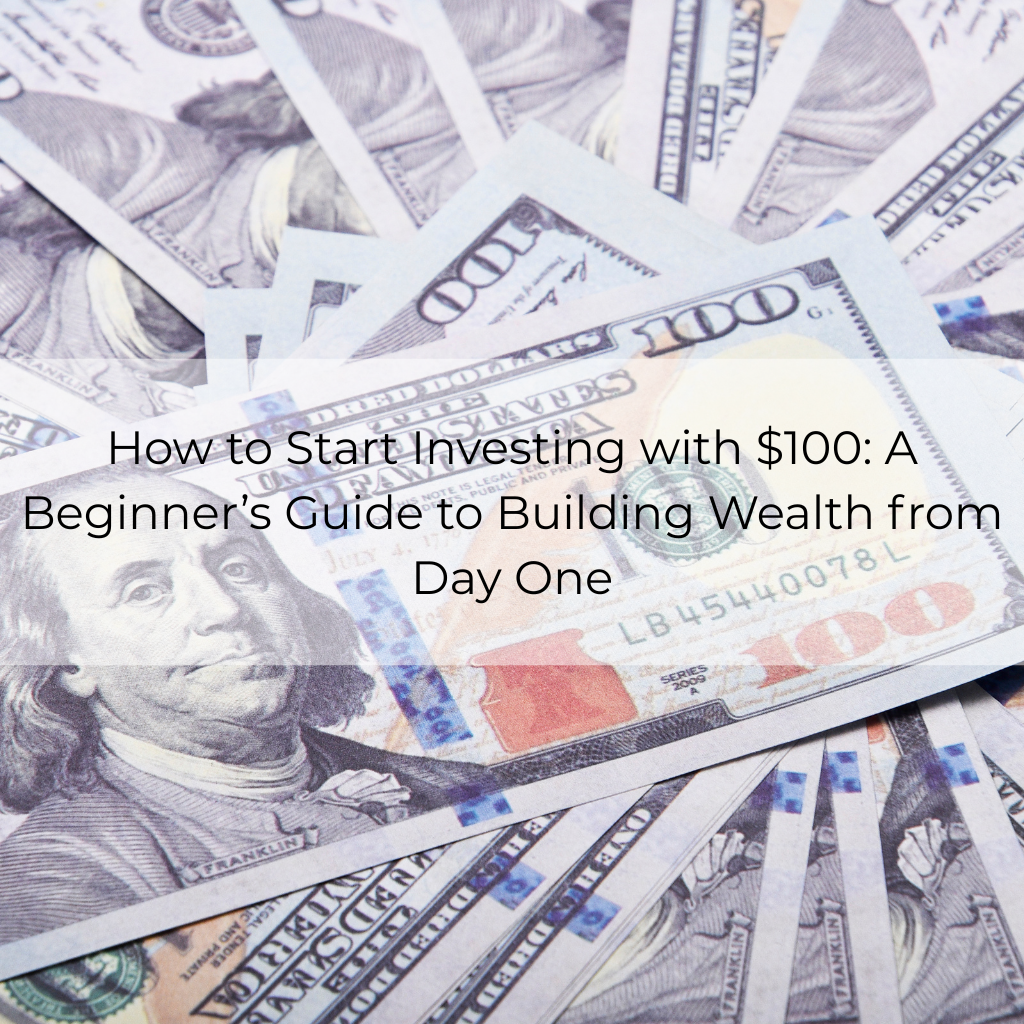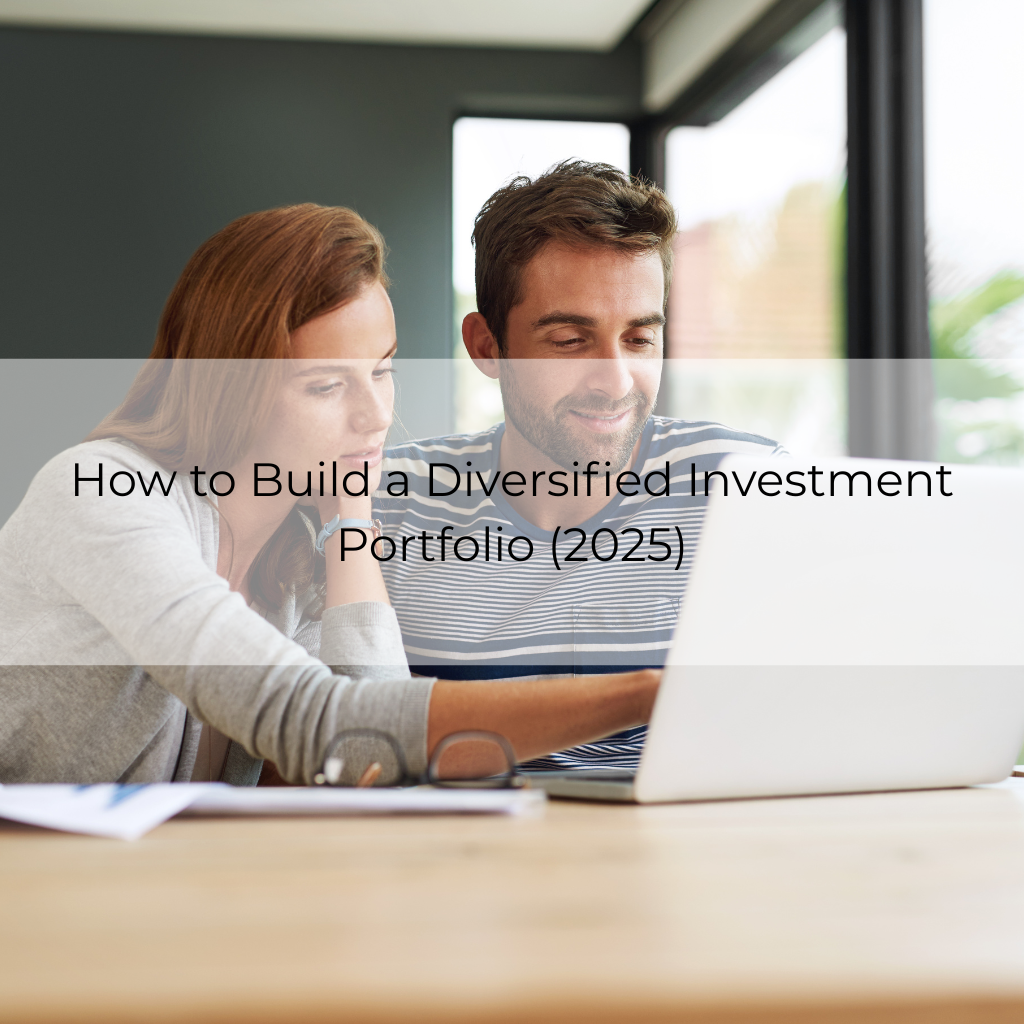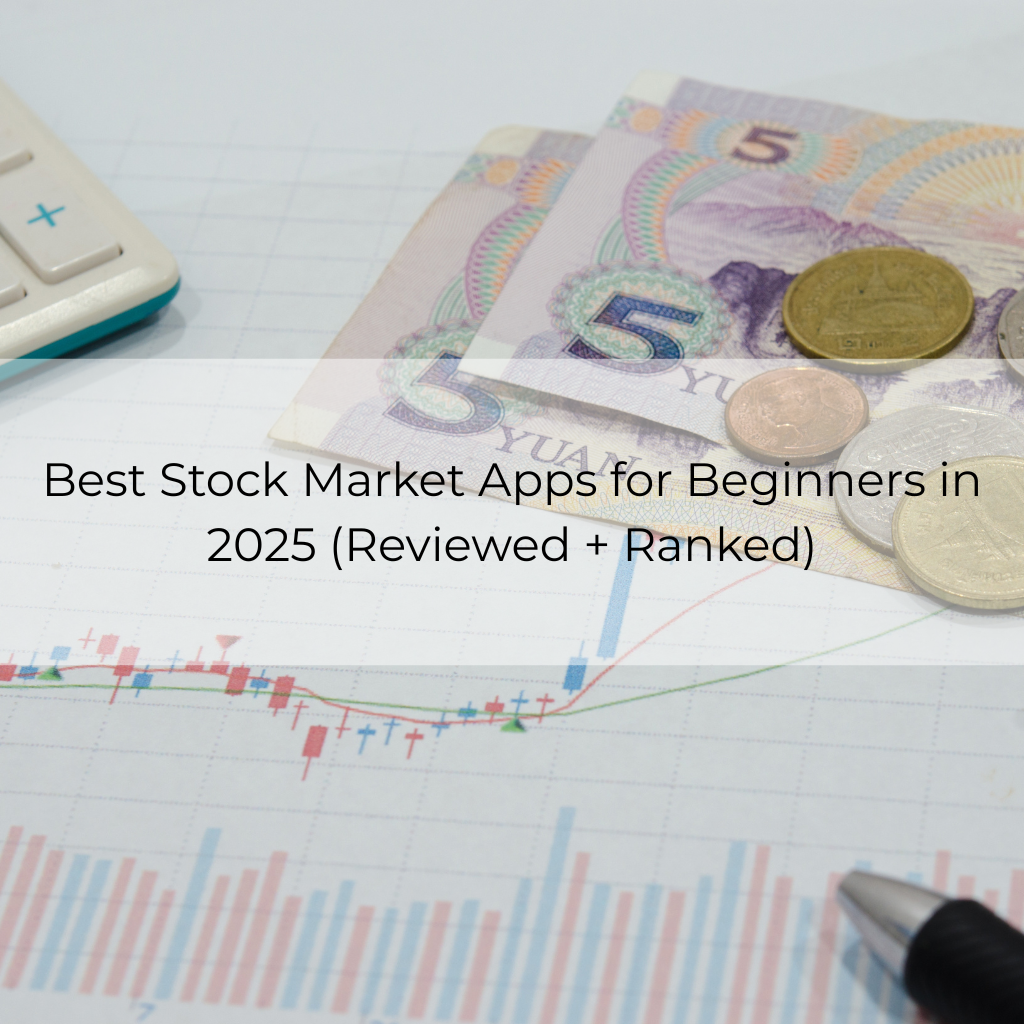How to Start Investing with $100: A Beginner’s Guide to Building Wealth from Day One

$100 Is Enough (Here’s Why)
Most people believe they need thousands of dollars to start investing. So they wait. And wait. And wait—while inflation quietly erodes their savings and compounding opportunities pass them by.
Here’s the truth: You don’t need a fortune to begin building wealth. You just need a hundred bucks and a plan.
Investing with $100 won’t make you rich overnight, but it will do something far more powerful—it gets you in the game. It’s the first domino in a chain that leads to better financial habits, smarter decisions, and long-term growth that actually changes your life.
This guide is built for beginners who are ready to stop waiting and start doing.
We’re going to show you:
- Why starting small works better than you think
- The platforms that make it possible (with no hidden fees)
- What to invest in (and what to avoid)
- How to build your first mini portfolio
- And the mindset that separates wealthy investors from the rest
$100 isn’t small. It’s the start of something bigger. Let’s make it count.
How to Build a Diversified Investment Portfolio (2025)
Why $100 Is More Powerful Than You Think
In the world of investing, the size of your first deposit matters way less than when you make it.
Here’s what most people get wrong: they think $100 won’t do anything. That it’s “not enough.” But that kind of thinking misses the point entirely.
Investing early beats investing big
Thanks to compound interest, the earlier you start, the more time your money has to multiply. A $100 investment today—followed by consistent small contributions—can grow into thousands over time without you ever needing to “go big.”
For example:
- Investing $100/month at an average 8% return over 25 years = ~$88,000+
- That’s not magic. That’s math—and time is the variable that most people waste
You’re training habits, not chasing gains
That first $100 isn’t just about making money—it’s about:
- Learning how investing works
- Overcoming the fear of doing it “wrong”
- Building the muscle of consistency
- Starting a system you’ll stick with as your income grows
Millionaires and successful investors almost always have one thing in common: they started. Then they didn’t stop.
Behavior > Budget
The average person waits to invest until they “have more money.” The disciplined person invests $100 and lets that action evolve into $500, then $1,000, then $10,000+. That compounding doesn’t just happen in your bank account—it happens in your habits.
Bottom line:
You’re not investing $100 to get rich.
You’re investing $100 to become the kind of person who builds wealth.
Think in Reps, Not Results
Investing and going to the gym are similar. Your first $100 isn’t meant to change your life — it’s meant to train your brain.
- The objective is not to “win” with a single deposit.
- It’s to practice consistency, discipline, and emotional control
- Over time, the reps compound — just like the money
Forget About Fast Money
If your goal is to double your money in a month, you’re not investing — you’re gambling. And most people who strive for quick wins end up losing even more quickly.
The real move? Play the long game.
- Focus on slow, steady, low-fee investments that build over time
- Understand that boring is profitable
- Accept that short-term returns don’t matter — habits do
Your First $100 Is About Identity
This isn’t just about buying a stock. It’s about becoming someone who invests.
It’s a shift from “saver” to “owner.” From “watcher” to “builder.”
You don’t need to get it perfect.
You just need to get it started.
- Your first $100 isn’t a bet.
- It’s a statement.
- You’re telling your future self: I don’t need perfect timing. I need consistent action.
Step-by-Step: How to Start Investing Your First $100
You’ve got the money. You’ve got the mindset. Now let’s move from thinking to doing.
Here’s your simple, beginner-proof roadmap to start investing your first $100 — even if you’ve never touched a brokerage account in your life.
Best Stock Market Apps for Beginners in 2025 (Reviewed + Ranked)
Step 1: Choose Your Platform
Pick an app or brokerage that:
- Allows fractional shares
- Has no/minimal fees
- Offers user-friendly mobile access
Great picks for beginners:
- M1 Finance (auto-investing + pie strategy)
- Fidelity or Vanguard (solid long-term platforms)
- SoFi / Public (modern UI + educational features)
- Betterment (fully automated, goal-based investing)
Don’t overthink it — just pick one and move.
Step 2: Connect Your Bank Account
- Link your checking account to your investment app
- This lets you deposit and withdraw funds
- Most platforms will guide you through a secure setup in under 5 minutes
Pro tip: Set up recurring transfers right away (even $25/week) to build momentum.
Step 3: Set a Goal for Your Investment
What’s this money for?
- Long-term growth?
- Passive income?
- Diversification?
Clarify this early. It helps shape what you invest in and keeps you from chasing trends later.
Step 4: Choose Your First Investment
Start with one of these low-risk, beginner-friendly options:
- Index Fund ETF like VTI or SPY (broad market exposure)
- Dividend ETF like SCHD (cash flow + growth)
- REIT ETF like VNQ (real estate exposure)
- Robo-portfolio (if you want it 100% managed for you)
These are better than trying to pick a single stock you barely understand.
Step 5: Make the Trade
This is the moment.
- Enter the amount ($100 or a fractional share)
- Confirm the trade
- Pat yourself on the back — you’re officially an investor
Step 6: Automate Your Habit
Set up recurring investments:
- Weekly or monthly deposits
- Auto-invest enabled (most platforms support it)
Why? Because this turns investing from a decision into a system — and systems build wealth.
You don’t need a financial advisor to invest your first $100.
You just need a platform, a plan, and the courage to hit “buy.”
Best Apps to Invest $100 (And Why)
Not all investing platforms are beginner-friendly — especially when you’re starting with just $100. You need:
- Low (or zero) fees
- Fractional share investing
- Automation features
- Simplicity and ease of use
Here’s a curated list of the best apps to start your investing journey with $100 — and why they actually make sense.
Quick Comparison Table (Drop-in Ready)
| Platform | Minimum | Best For |
|---|---|---|
| M1 Finance | $100 | Automated investing with custom “pies” |
| Betterment | $10 | Hands-off robo-advisor portfolios |
| Public / SoFi | $1 | Social investing + education tools |
| Fundrise | $10 | Real estate investing with low capital |
| Robinhood | $1 | Quick, no-frills stock/ETF investing |
| Fidelity / Vanguard | $0 | Long-term index fund investing |
Why These Work for $100 Investors:
- Fractional shares: You can own part of expensive stocks (like Apple or Tesla) with just a few bucks
- No commissions: These platforms are low- or zero-fee, so small investors aren’t penalized
- Automation: Some (like M1 and Betterment) let you “set it and forget it” with recurring deposits + reinvestments
- Education-friendly: Platforms like SoFi and Public are built with beginner knowledge tools built in
Bottom line:
All of these platforms are beginner-proof, low-risk, and scalable. You can start with $100 and keep growing without needing to switch later.
Where to Invest $100 – Best Strategies for Small Capital
Once your $100 hits your investment account, the big question becomes:
“Where do I put it?”
The Power of Compound Interest: How to Make Your Money Work While You Sleep
Forget meme stocks, TikTok tips, and high-risk gambles. When you’re starting small, the best strategy is to build a foundation—not chase fireworks.
Here are beginner-proof, high-leverage ways to make that $100 work smart (not risky).
1. Fractional Shares of Index Funds (VTI, SPY)
Index funds give you instant diversification by tracking a broad section of the market.
- VTI: Total U.S. Stock Market (over 4,000 companies)
- SPY: Tracks the S&P 500 (top 500 U.S. companies)
- Extremely low fees (0.03–0.05%)
- Great for long-term growth and compounding
Why it works: You’re not betting on one company — you’re betting on America’s economy as a whole
2. Dividend ETFs (like SCHD)
Dividend-focused ETFs give you exposure to stable companies that pay you regularly.
- SCHD: High-dividend ETF with long-term growth
- Reinvested dividends = faster compounding
- Great for passive income over time
Why it works: Even $100 can start generating tiny cash flow, which snowballs when reinvested.
3. REITs or Real Estate ETFs
Real Estate Investment Trusts let you invest in real estate without owning physical property.
- Examples: VNQ (Vanguard Real Estate ETF), Fundrise (private REIT)
- Earn income through rental yields and appreciation
- Diversifies your portfolio beyond just stocks
Why it works: Real estate without tenants, mortgages, or down payments.
4. Robo-Advisors (Like Betterment)
If you don’t want to choose individual investments, robo-advisors do it for you.
- You answer a few questions about your goals + risk tolerance
- They build and manage a portfolio of ETFs automatically
- Fees are low (~0.25%) and worth it for the hands-off experience
Why it works: Perfect for total beginners who just want to “set it and forget it”
5. High-Yield Savings or CD Ladder (Short-Term Parking)
Not technically investing, but if you’re ultra risk-averse or planning to use that $100 soon, a high-yield savings account or CD ladder is a smart move.
- No risk of loss
- Earn 4–5% APY (as of now)
- Great for emergency funds or very short timeframes
Why it works: Beats letting it sit in a 0.01% savings account.
Bonus: Split Your $100 for Balanced Exposure
Not sure where to start? Here’s a simple sample split:
- $50 in VTI (broad market ETF)
- $25 in SCHD (dividend ETF)
- $25 in Fundrise (real estate exposure)
This way, you’re building a diversified micro-portfolio right from the start.
It’s not about finding the “perfect” investment — it’s about choosing proven, low-cost assets that help you learn and build wealth over time.
Realistic Portfolio Example (for a $100/Month Habit)
Once you’ve made your first $100 investment, the smartest move isn’t chasing fast returns. It’s building a repeatable monthly habit that compounds over time.
Here’s how you can turn $100/month into a simple, powerful portfolio—without overthinking it.
Stock Market vs. Real Estate: Which is the Better Investment?
Suggested Allocation:
- 50% – Total Market ETF (e.g. VTI)
Broad exposure to thousands of U.S. companies. Simple, diversified, long-term growth. - 30% – Dividend ETF (e.g. SCHD)
Adds stability and regular dividend income that can be reinvested. - 20% – Real Estate Exposure (REIT ETF like VNQ or Fundrise)
Gives your portfolio a physical asset class without needing to buy property.
Monthly Breakdown:
- $50 into VTI
- $30 into SCHD
- $20 into VNQ or Fundrise
You can invest this manually or automate it using tools like M1 Finance, Betterment, or a recurring investment setup on your broker app.
What This Does for You:
- Diversifies your risk across multiple sectors and asset classes
- keeps fees for passive funds and ETFs low.
- Builds the habit of consistent, long-term investing
- Lets your returns compound without constant micromanagement
Reminder:
Even small, regular investments grow significantly over time. If you invest $100/month for 10 years at an average 8% return, you’ll end up with nearly $18,000.
You don’t need a complicated portfolio to succeed.
You just need clarity, consistency, and time.
Mistakes to Avoid When Starting Small
Starting with $100 is a smart move — but it’s also a slippery slope if you don’t manage your expectations and behavior. Here are the most common mistakes that drain motivation, destroy returns, or kill momentum early on.
1. Chasing Hype Instead of Strategy
Trying to “get rich” off $100 by buying the latest hot stock or crypto trend is a fast way to learn a hard lesson.
Don’t chase:
- Meme stocks
- Viral TikTok picks
- Reddit pumps
- Micro-cap lottery tickets
Instead, stick to broad, proven assets that build over time.
2. Expecting Fast Results
$100 isn’t going to double in a month. That’s not how real investing works.
If you’re constantly checking your balance, you’re playing the wrong game.
Investing is a slow grind upward — not a jackpot pull.
3. Overcomplicating Your Portfolio
At the beginning, complexity kills. You don’t need:
- 10 different funds
- Sector-specific bets
- International plays with currency risk
Focus on 2–3 solid assets that you understand.
4. Ignoring Fees and Expense Ratios
If you’re investing $100, a 1% fee is literally costing you $1/year — sounds small, right? But compound that over decades, and it adds up fast.
Stick with:
- Index funds
- ETFs with expense ratios below 0.10%
- Fee-free platforms
5. Stopping When Life Gets Busy
Skipping one month turns into three… then a year.
The most powerful thing you can do? Automate it. Even $25/month on autopilot beats perfect timing.
Consistency > intensity.
6. Investing Without Understanding
Buying into something because it “looks cool” or someone on YouTube said so is a bad strategy.
Before you invest a dollar, ask:
- What is this?
- Why does it make money?
- How does it fit into my goals?
Your first $100 investment isn’t about being clever — it’s about being consistent.
Avoid these beginner traps, and you’ll be 10 steps ahead of most new investors.
Conclusion – $100 Is Just the Beginning
The majority of people wait their entire lives for the “ideal moment” to begin investing.
Waiting for more money.
Waiting for less risk.
Waiting for confidence.
Here’s what they don’t realize: You don’t wait your way into wealth. You build your way into it.
Starting with $100 may not sound like much — and honestly, it’s not supposed to.
It’s not about getting rich off one investment.
It’s about creating a system. A habit. A mindset that says:
“I don’t have to be rich to start. But I have to start to get rich.”
You now know:
- Where to invest $100 wisely
- Which platforms make it simple
- How to create a modest but varied portfolio
- What mistakes to avoid as you grow
- And most importantly — how to think like an investor, even with small capital
Because the first $100? That’s just your entry fee.
The real compounding begins when you show up again next month. And the next. And the next.
Final thought:
It’s not about timing the market. It’s not about finding the next big thing.
It’s about starting small, staying consistent, and letting time do its job.
You’ve made your first move.
Now make it a habit.
SEO Disruptor | Paid Ads Architect | Content Alchemist | I don’t just rank pages
I build profit machines. From SEO domination to ads that print revenue, I turn digital noise into real-world business growth. Let’s connect




